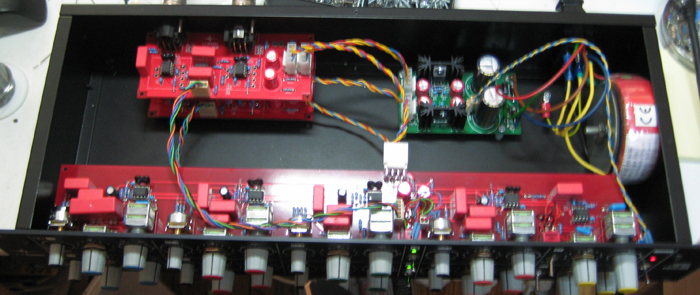Holger said:My third:


I can really recommend this EQ. Jump on this as long as Igor stocks it...
what op amps are you using?
Holger said:My third:


I can really recommend this EQ. Jump on this as long as Igor stocks it...
Holger said:2604/604
Biasrocks said:Hoping for a quick favor from a kind soul with a working build.
I'm having some problems with my cut's / gain structure in my build.
http://www.groupdiy.com/index.php?topic=27972.msg593590#msg593590
I get healthy AC voltage on PIN 1 (Boost bus) of the I/O - EQ board connector but low voltage on PIN 3 (Cut buss) which I think may be the problem.
If you inject a line level 1khz tone on the input, with the boost/cut control centered and the EQ IN; what are the AC voltages present on PIN 1 and PIN 3. I'm guessing they should be around the same level, but I'm not sure.
This would help me track down this last gremlin.
Regards,
Mark
Assuming healthy=unity gain, polarity inverted=0dB at pin1 with 0dB input signal feed.Biasrocks said:I get healthy AC voltage on PIN 1 (Boost bus) of the I/O - EQ board connector
When disconnecting the filter board, output of IC6 or XLR-out pin2 will read same level and polarity as input level and opamp will stay cool, else IC6 or servo IC10a might be blown.but low voltage on PIN 3 (Cut buss) which I think may be the problem.
I've checked levels on each of the 20K summing resistors and when I apply full boost centered at 1khz I'm getting around 1.5Vac of signal before the resistor and about 1/10th of that after the summing resistors.
My output OPA604's are running super hot as well, not sure if that's normal.
Just run the numbers for maybe CF5.1 to know why your 5pF wouldn't make a difference ... ( 1/(2PI*11K*5E-12) LPF at 2.9MHz wouldn't help that much when opamp runs out of GBW). A 47pF might be a better fit. The 12pF comp.caps C23 and C57 across the 20Ks at 660kHz are on the high side as well. Wouldn't go lower than 27pF, but as always YMMV.Biasrocks said:My remaining problem is an oscillation in the individual bands. High bands are more suseptible than the low bands but I can get every band ringing like a bell. High bands will start after about 3db of boost.
I'm using verified good OPA2604's for each band. I went through an added the 5pf compensation caps to each band (which Igor doesn't recommend for 2604's) with no difference. Moved wires around with no difference.
Not sure if this could this be power supply decoupling issues or more of a frequency compensation issue.
Igor said:Hi, I bought opa604's last time from digikey, but for now seems they
doesn't have them. Farnell is another option.
Regarding resistors, R-EU_0207/12 means 1/4w, 12 mm pitch.
I.e. common 1/4w resistor.
I used to draw pcbs in Eagle, really good prog ,but bom-wise, it is bad
Biasrocks said:It seems strange that no one is having this problem with their 2604's.
Biasrocks said:Nice, the GBW is almost triple that of the 2604 and the slew rate is 5/Vus slower than the 2604.
Biasrocks said:We're already running very close to 22v rails with the 22 ohm PS "fuse" resistors installed, no big deal to adjust those slightly.
atticmike said:Igor said:Hi, I bought opa604's last time from digikey, but for now seems they
doesn't have them. Farnell is another option.
Regarding resistors, R-EU_0207/12 means 1/4w, 12 mm pitch.
I.e. common 1/4w resistor.
I used to draw pcbs in Eagle, really good prog ,but bom-wise, it is bad
Pitch as in length or diameter?
what about the lead spacing?
So you are saying 0207 and 0204 are the same? 207 is just a building type and 207 & 204 are 1/4 therewith?
I thought 204 were the ones that small ones that easily roll off your board?
Mike
atticmike said:atticmike said:Igor said:Hi, I bought opa604's last time from digikey, but for now seems they
doesn't have them. Farnell is another option.
Regarding resistors, R-EU_0207/12 means 1/4w, 12 mm pitch.
I.e. common 1/4w resistor.
I used to draw pcbs in Eagle, really good prog ,but bom-wise, it is bad
Pitch as in length or diameter?
what about the lead spacing?
So you are saying 0207 and 0204 are the same? 207 is just a building type and 207 & 204 are 1/4 therewith?
I thought 204 were the ones that small ones that easily roll off your board?
Mike
can anybody assist me with my question ?
abechap024 said:I don't think you could find any of those parts in a low enough voltage value for it to be a problem. You want to have them rated at least the amount of the highest possible voltage they will see in the given circuit. No harm in getting a capacitor rated at a higher voltage though.
Most people run into problems when they order a bunch of low voltage electrolytic and put them in a power supply rated over the max voltage of the electrolytic capacitor and before long...pop! Film and ceramic on the other-hand usually are at least rated at 50v and unless you are building some high voltage tube stuff, you are going to always be fine.
Enter your email address to join: